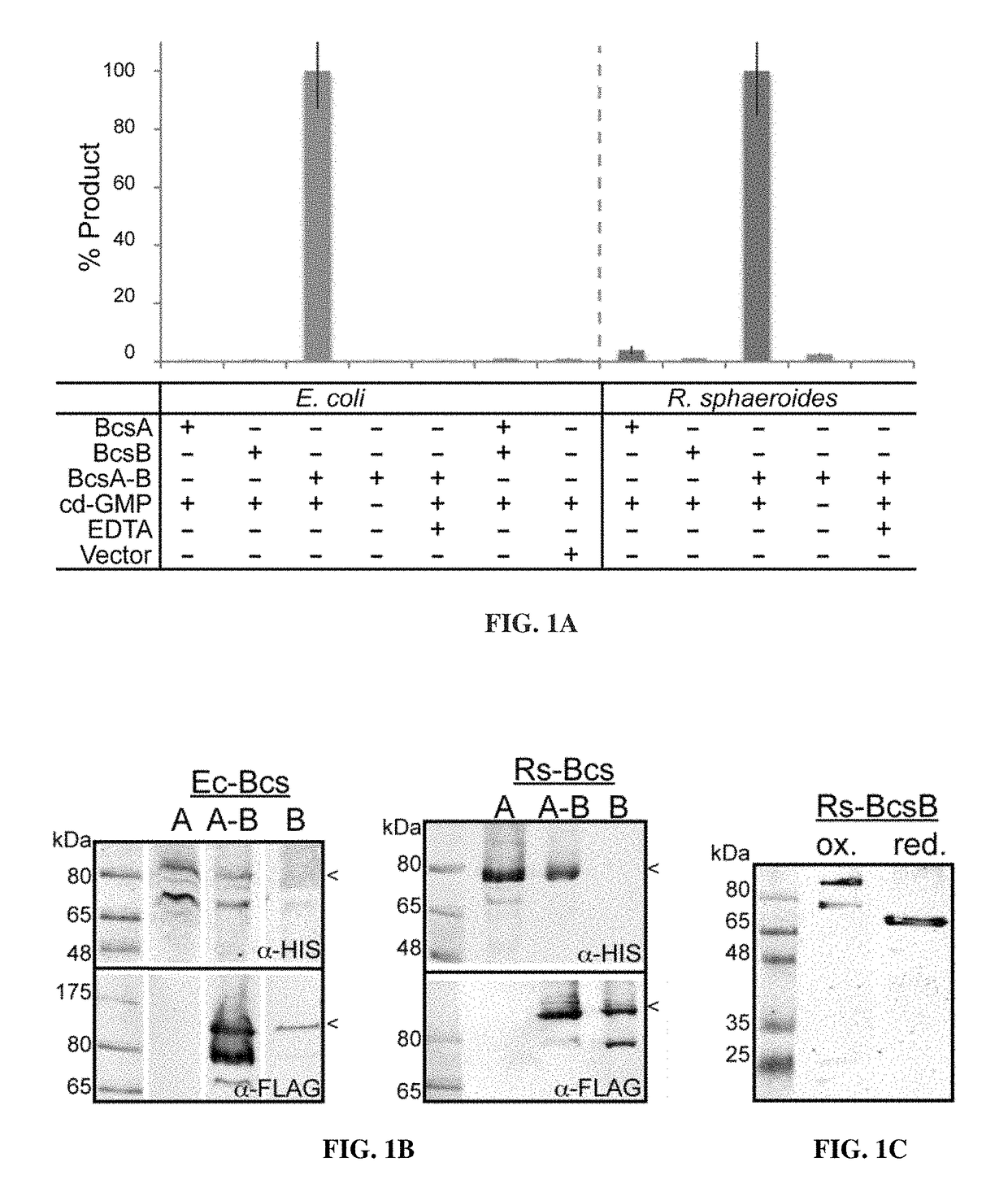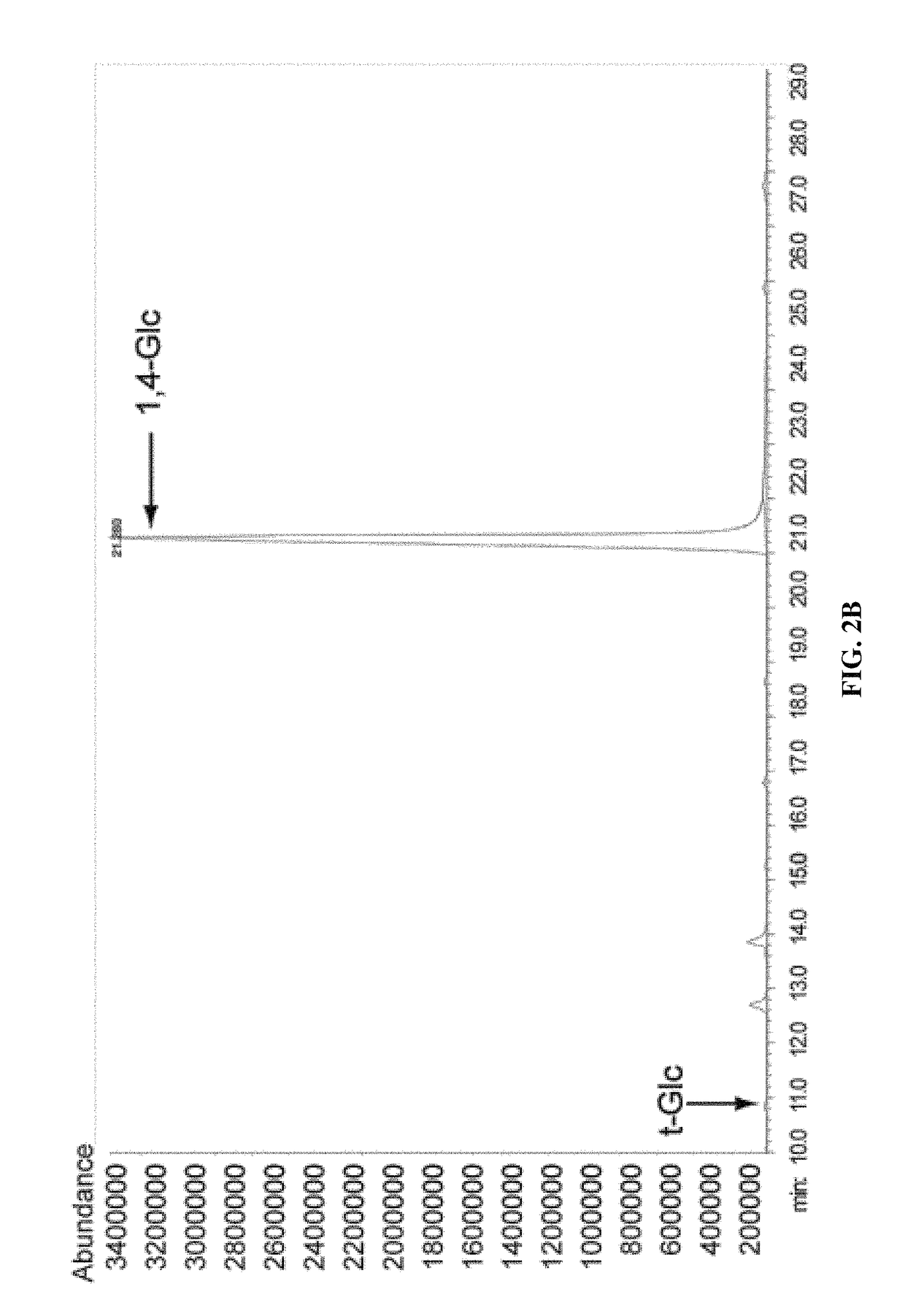Method for synthesizing cellulose in vitro
a cellulose and in vitro technology, applied in the direction of enzymology, peptides, transferases, etc., can solve the problem of difficult reconstituting cellulose synthesis in vitro from purified components
- Summary
- Abstract
- Description
- Claims
- Application Information
AI Technical Summary
Benefits of technology
Problems solved by technology
Method used
Image
Examples
embodiments
[0209]Fragments of SEQ ID NO:1 (BcsA; 788 a.a. residues) include, for example, fragments comprising residues 1-787, 1-786, 1-785, etc. down to about residues 1-15. Fragments further include those of about residue positions 2-788, 20-788, 40-788, 100-788, 200-788, 250-788, 300-788, 350-788, 400-788, 450-788, 500-788, 550-788, 600-788, 650-788, 700-788, and 750-788. They also include fragments having a size of about 10 amino acids in length, 15, 20, 25, 35, 50, 75, 100, 125, 150, 175, 200, 250, 275, 300, 350, 400, 450, 500, 550, 600, 650, 700, 750, etc., up to about 787 amino acid residues in length. One of ordinary skill in the art will know which fragment to use or test based on the desired activity.
[0210]Fragments of SEQ ID NO:3 (Rhodobacter sphaeroides BcsB; 725 a.a. residues) include, for example, fragments comprising residues 1-724, 1-723, 1-722, etc. down to about residues 1-15 of BcsB. However, the main activity resides in the C-terminus, so preferable fragments will include t...
example 1 bibliography
[0301]1. Hubbard C, McNamara J T, Azumaya C, Patel M S, Zimmer J (2012) The hyaluronan synthase catalyzes the synthesis and membrane translocation of hyaluronan. J Mol Biol 418:21-31.[0302]2. Morgan J L, Strumillo J, Zimmer J (2013) Crystallographic snapshot of cellulose synthesis and membrane translocation. Nature 493:181-186.[0303]3. Nishiyama Y, Sugiyama J, Chanzy H, Langan P (2003) Crystal structure and hydrogen bonding system in cellulose I(alpha) from synchrotron X-ray and neutron fiber diffraction. J Am Chem Soc 125:14300-14306.[0304]4. Romling U (2002) Molecular biology of cellulose production in bacteria. Res Microbiol 153:205-212.[0305]5. Somerville C (2006) Cellulose synthesis in higher plants. Annu Rev Cell Dev Biol 22:53-78.[0306]6. Grimson M J, Haigler C H, Blanton R L (1996) Cellulose microfibrils, cell motility, and plasma membrane protein organization change in parallel during culmination in Dictyostelium discoideum. J Cell Sci 109:3079-3087.[0307]7. Cantarel B L, C...
example 1
Supplementary Bibliography
[0350]1. Morgan J L, Strumillo J, Zimmer J (2013) Crystallographic snapshot of cellulose synthesis and membrane translocation. Nature 493:181-186.[0351]2. Wagner S, Klepsch M M, Schlegel S, Appel A, Draheim R, Tarry M, Hogbom M, van Wijk K J, Slotboom D J, Persson J O et al. (2008) Tuning Escherichia coli for membrane protein overexpression. Proc Natl Acad Sci USA 105:14371-14376.[0352]3. Hubbard C, McNamara J T, Azumaya C, Patel M S, Zimmer J (2012) The hyaluronan synthase catalyzes the synthesis and membrane translocation of hyaluronan. J Mol Biol 418:21-31.[0353]4. Denisov I G, Grinkova Y V, Lazarides A A, Sligar S G (2004) Directed self-assembly of monodisperse phospholipid bilayer Nanodiscs with controlled size. J Am Chem Soc 126:3477-3487.[0354]5. Origin OriginLab, Northampton, Mass.[0355]6. Ciucanu I, Kerek F (1984) A simple and rapid method for the permethylation of carbohydrates. Carbohydr Res 131:209-217.[0356]7. Albersheim P, Nevins P D, English ...
PUM
| Property | Measurement | Unit |
|---|---|---|
| temperature | aaaaa | aaaaa |
| molecular weight | aaaaa | aaaaa |
| molecular weight | aaaaa | aaaaa |
Abstract
Description
Claims
Application Information
 Login to View More
Login to View More - R&D
- Intellectual Property
- Life Sciences
- Materials
- Tech Scout
- Unparalleled Data Quality
- Higher Quality Content
- 60% Fewer Hallucinations
Browse by: Latest US Patents, China's latest patents, Technical Efficacy Thesaurus, Application Domain, Technology Topic, Popular Technical Reports.
© 2025 PatSnap. All rights reserved.Legal|Privacy policy|Modern Slavery Act Transparency Statement|Sitemap|About US| Contact US: help@patsnap.com



